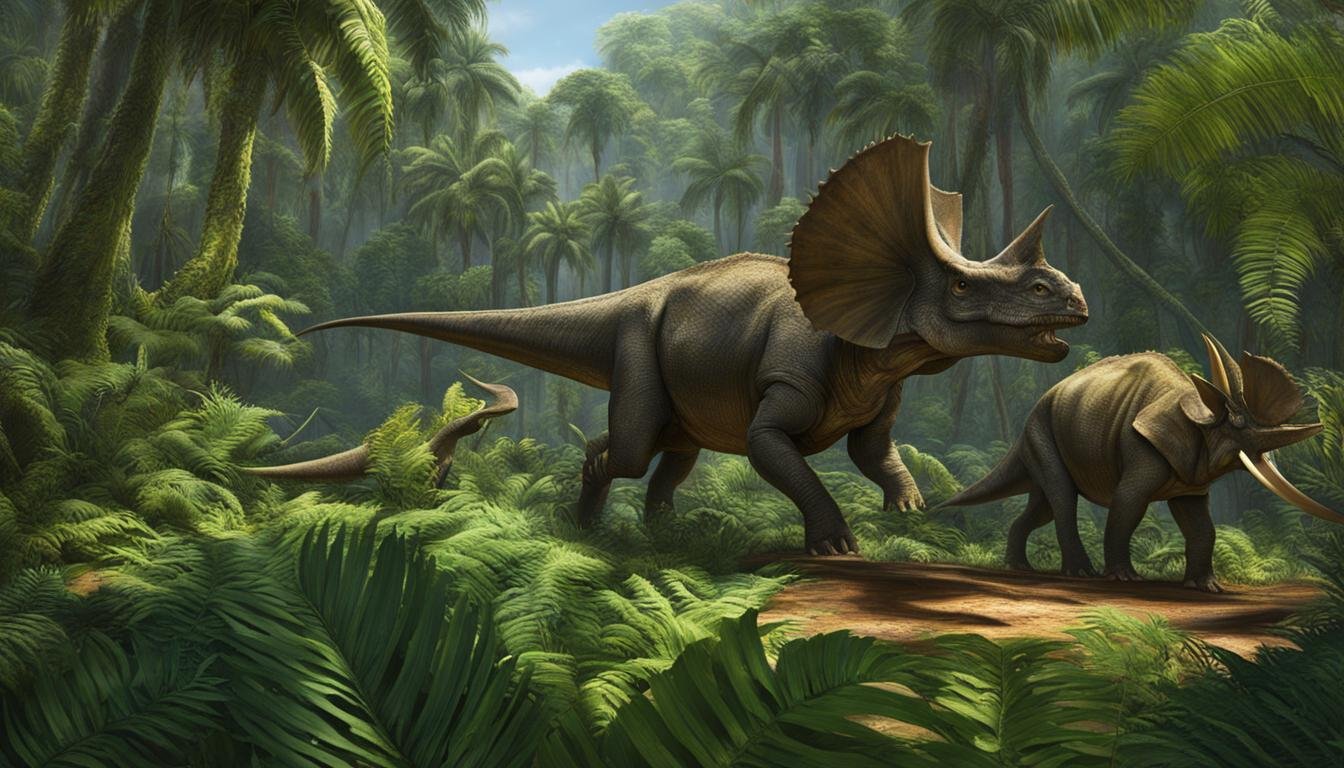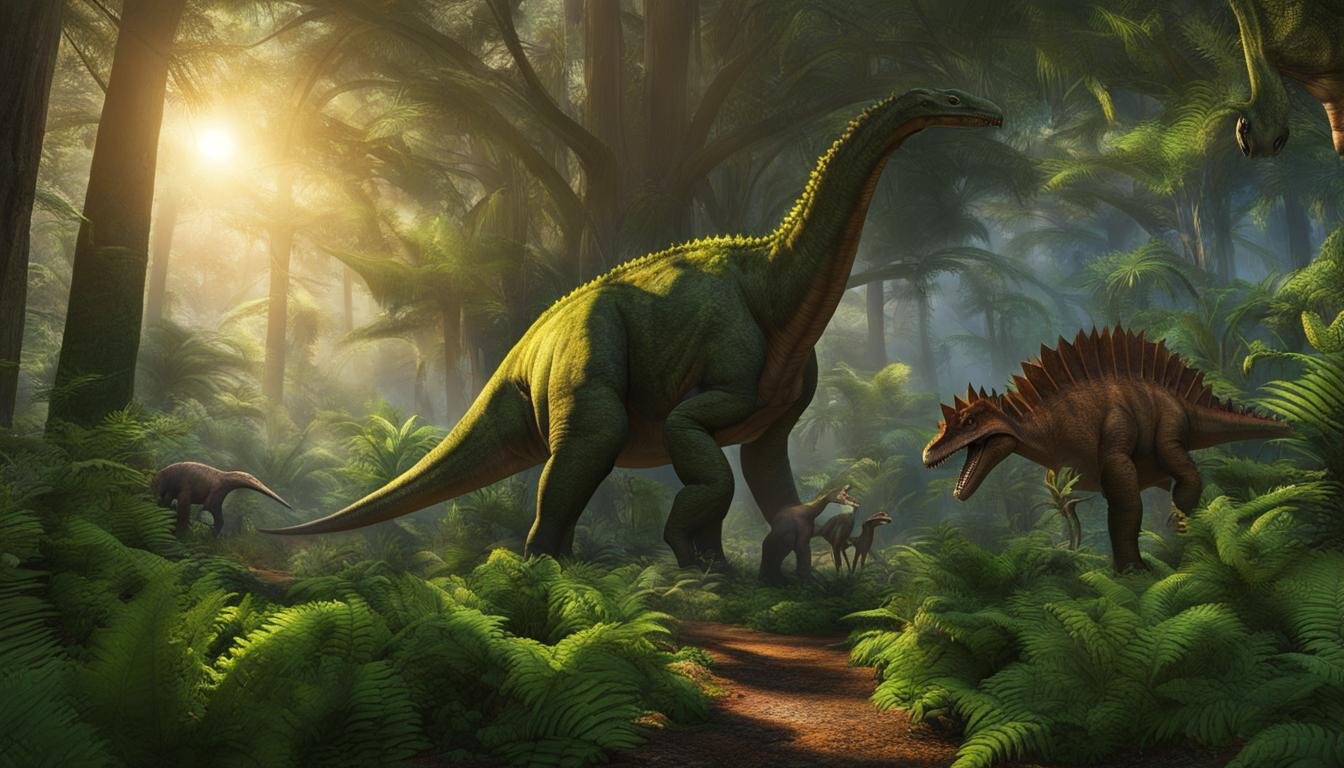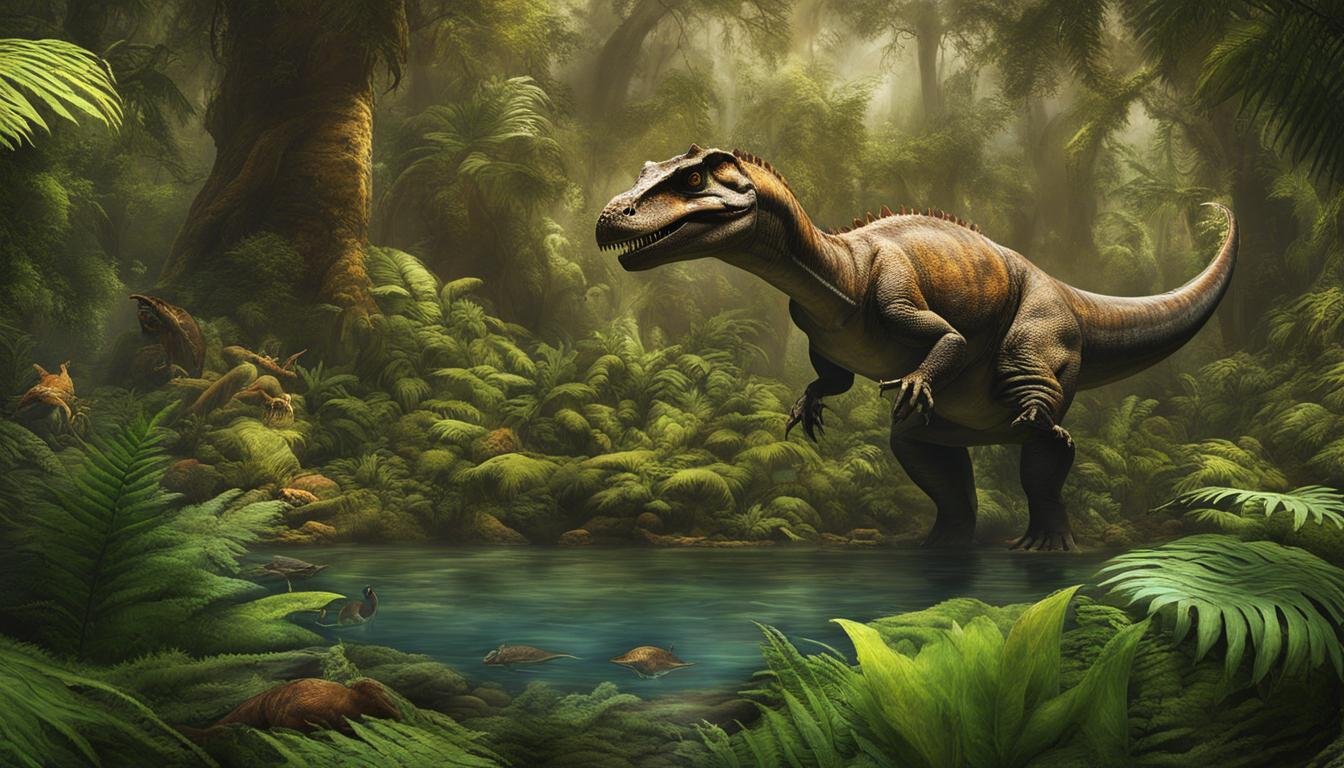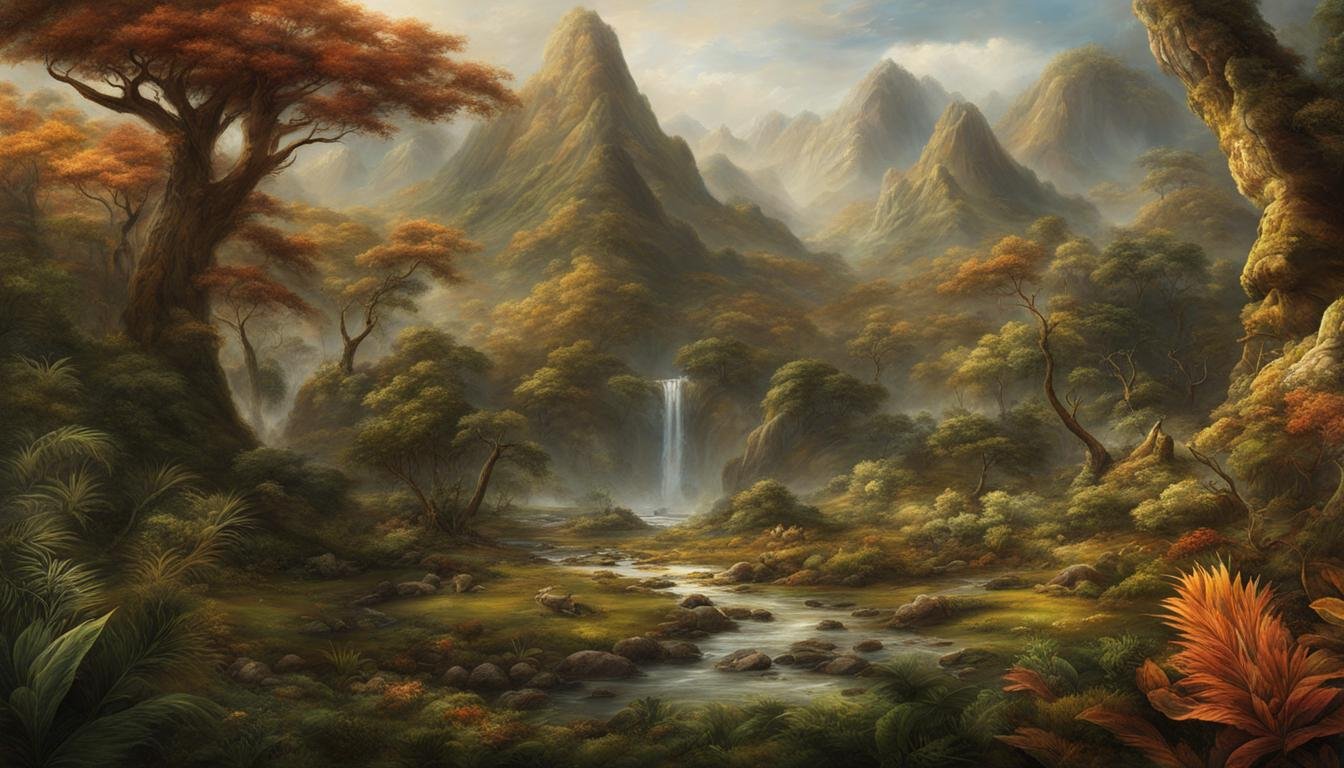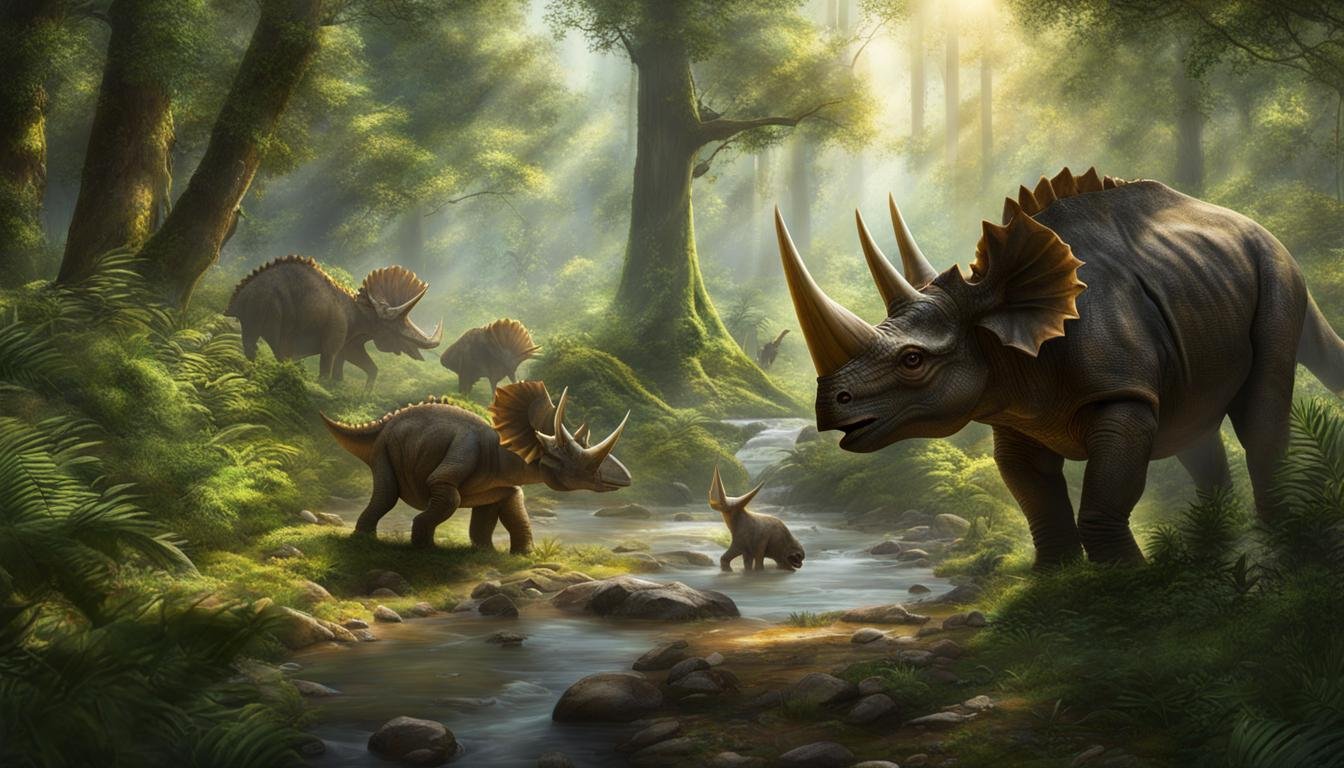Did you know that dinosaurs shared their ancient world with a wide variety of other prehistoric creatures? While dinosaurs may have reigned supreme for over 180 million years, they were not the only inhabitants of the planet during that time. Crocodiles, snakes, bees, sharks, horseshoe crabs, sea stars, lobsters, duck-billed platypuses, tuatara, and even cockroaches are just a few examples of the fascinating creatures that coexisted with dinosaurs.
This coexistence provides a captivating glimpse into the ancient ecosystem and the dynamics of the prehistoric animal community. It’s remarkable to think about how different species interacted and competed for resources in this primordial world. Let’s dive deeper into the fascinating interactions between dinosaurs and other prehistoric creatures.
| Main Point | Description |
|---|---|
| Coexistence with Dinosaurs | Various prehistoric animals, including crocodiles, snakes, and bees, shared ecosystems with dinosaurs, often competing for resources. |
| Diversity of Ancient Creatures | The ecosystems of dinosaurs included a wide array of creatures such as sharks, horseshoe crabs, sea stars, lobsters, duck-billed platypuses, tuatara, and cockroaches. |
| Survival of Crocodiles and Snakes | Crocodiles and snakes were among the formidable predators that not only coexisted with dinosaurs but also adapted and survived alongside them. |
| Thriving Prehistoric Animals | Bees, sharks, and other prehistoric animals managed to thrive in the same ecosystems as dinosaurs, adapting to environmental changes and surviving multiple extinction events. |
| Primates and Dinosaurs | The existence of primates during the time of dinosaurs remains a debated topic, but recent research suggests they were beginning to evolve just before the mass extinction event that ended the reign of dinosaurs. |
Crocodiles and Dinosaurs
During the dinosaur era, crocodiles were not just lurking in the shadows; they were formidable predators that coexisted with dinosaurs in their shared habitats. These ancient crocs, including the massive Sarcosuchus and Deinosuchus, made the prehistoric world an even more terrifying place. Fossil evidence suggests that crocodiles and dinosaurs interacted, creating an intricate web of predator-prey relationships and competition for resources.
“The coexistence of crocodiles and dinosaurs during the dinosaur era highlights the complex dynamics of prehistoric ecosystems. These crocs were not mere spectators; they actively interacted with dinosaurs, shaping the balance of power in their ancient habitats.”
These crocodilian creatures were well adapted to their environments, utilizing their powerful jaws and stealth to hunt and survive alongside dinosaurs. While dinosaurs may have been the dominant species, crocodiles held their own and played a vital role in the intricate tapestry of the prehistoric animal community.
| Crocodiles | Dinosaurs |
|---|---|
| Survived for over 240 million years | Varied in lifespan, with some species surviving for millions of years |
| Adapted to both land and water environments | Primarily land-dwelling, with some adapted to aquatic or aerial lifestyles |
| Strong jaw muscles for powerful biting force | Varied jaw structures depending on diet, some with powerful bites |
| Shared habitats with dinosaurs | Coexisted with various species of dinosaurs |
| Active predators, feeding on a variety of prey | Varied diets, including herbivorous and carnivorous species |
The interaction between crocodiles and dinosaurs during the prehistoric era provides valuable insights into the complex dynamics of ancient ecosystems. Understanding these interactions helps us piece together a more complete picture of life during the age of dinosaurs and the intricate web of coexistence among prehistoric animals.
Snakes and Dinosaurs
Snakes, ancient reptiles known for their slithering movements and venomous bites, managed to survive the age of dinosaurs. Fossil evidence suggests that snakes existed alongside these formidable predators, cohabitating in the same ecosystems. These adaptable creatures not only found ways to coexist with dinosaurs but also took advantage of the young offspring of these fearsome predators for sustenance.
During the dinosaur era, snakes evolved to fit into various ecological niches. Some species, such as Sanajeh indicus, were even specialized in preying on dinosaur eggs. The discovery of fossilized snake eggs alongside dinosaur nests in India offers compelling evidence of this unique interaction. These ancient snakes likely targeted the vulnerable eggs as a source of food, taking advantage of the abundance of dinosaur offspring.
While it is unclear how snakes and dinosaurs interacted on a day-to-day basis, their cohabitation provides insight into the intricate web of life that existed during this time. Snakes were able to adapt to their environment and carve out their own niche within the prehistoric ecosystems, highlighting their resilience and ability to survive alongside such formidable competitors.
Snakes and Dinosaurs: A Prehistoric Relationship
The coexistence of snakes and dinosaurs during the prehistoric era is a testament to the remarkable adaptability of both groups of creatures. While dinosaurs may have dominated the Earth for millions of years, snakes were able to find their place in the ecosystem and thrive alongside these mighty beasts. Their ability to cohabitate with dinosaurs and even prey on their young reveals the complex dynamics of the prehistoric world and the interplay between different species.
| Snake Species | Dinosaur Prey | Fossil Evidence |
|---|---|---|
| Sanajeh indicus | Dinosaur eggs | Fossilized snake eggs found alongside dinosaur nests in India |
| Titanoboa | Unknown | Fossil evidence suggests Titanoboa coexisted with dinosaurs in South America |
| Madtsoia | Unknown | Fossil evidence of Madtsoia suggests it may have inhabited the same ecosystems as dinosaurs |
The discovery of fossilized evidence showcasing the presence of snakes alongside dinosaurs adds to our understanding of the ancient world. It provides a glimpse into the coexistence and interaction between different prehistoric species, shedding light on the complex relationships that shaped our planet millions of years ago.
As we continue to uncover more fossils and study the remnants of prehistoric life, our knowledge of the cohabitation of snakes and dinosaurs grows. These findings deepen our understanding of the diverse ecosystems and the remarkable adaptability of ancient creatures that existed during the dinosaur era.
Bees, Sharks, and Other Prehistoric Animals
Bees and sharks, two iconic creatures of the prehistoric world, were among the many animals that coexisted with dinosaurs. Bees have a rich history that dates back to the same time as dinosaurs, with their origin believed to be in the Cretaceous period. As the first flowering plants began to bloom, bees evolved alongside dinosaurs, forming a crucial symbiotic relationship. They played a vital role in pollination, contributing to the diversification of plant life during this ancient era. This interdependency between bees and dinosaurs sheds light on the intricate web of life and the ancient ecosystem’s cohabitation.
Sharks, on the other hand, have a lineage that predates the dinosaurs, with a history stretching back around 450 million years. These ancient creatures not only survived the extinction event that wiped out the dinosaurs but thrived in the post-dinosaur world. With their unmatched predatory skills and adaptability, sharks continue to inhabit our oceans today, providing a glimpse into a prehistoric era when they coexisted with dinosaurs. Their presence in the ancient seas highlights the resilience and longevity of these remarkable creatures.
In addition to bees and sharks, other prehistoric animals such as horseshoe crabs, sea stars, lobsters, duck-billed platypuses, tuatara, and cockroaches also lived alongside dinosaurs. Each of these species adapted to their unique environments and managed to survive through various extinction events. The cohabitation of these diverse creatures showcases the complexity and resilience of the ancient ecosystem. From the land to the sea, these prehistoric animals played their roles, shaping the world that dinosaurs inhabited.
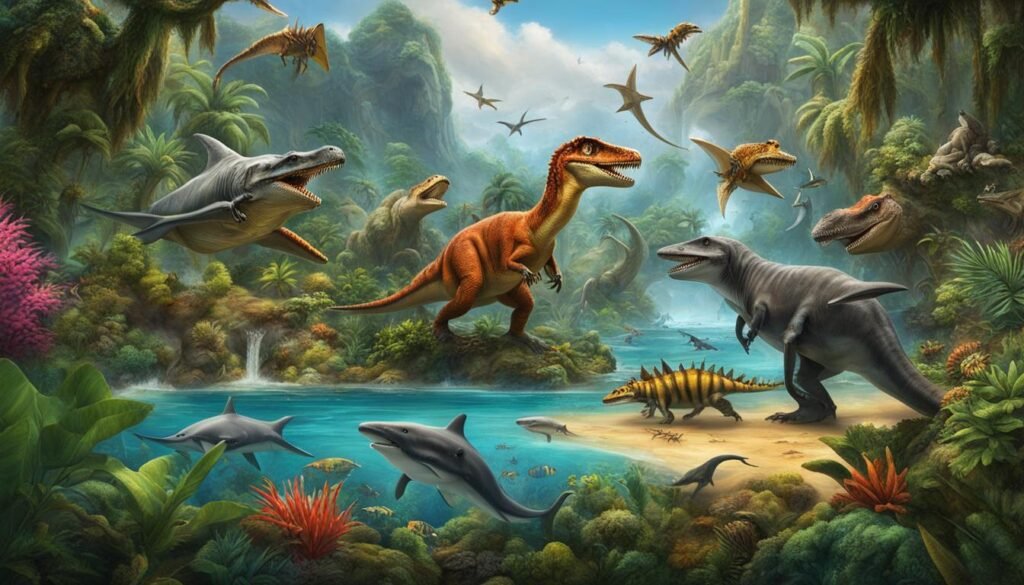
| Animal | Time Period | Role in the Ecosystem |
|---|---|---|
| Bees | Cretaceous | Pollination, diversification of plant life |
| Sharks | Various, predating dinosaurs | Top predators in ancient seas |
| Horseshoe crabs | Ordovician to present | Survivors of multiple extinction events |
| Sea stars | Ordovician to present | Contributors to marine biodiversity |
| Lobsters | Devonian to present | Scavengers, vital to marine ecosystems |
| Duck-billed platypuses | Various, predating dinosaurs | Unique mammals with diverse adaptations |
| Tuatara | Cretaceous to present | Living fossils, conservation indicators |
| Cockroaches | Carboniferous to present | Survivors with resilience and adaptability |
Primates and the Coexistence Theory
The coexistence of primates with dinosaurs has long been a subject of debate among scientists. A recent study suggests that the ancestors of primates, along with other mammals like rabbits, hares, dogs, and cats, were coexisting with dinosaurs and even evolving just before the mass extinction event. After dinosaurs went extinct, placental mammals like primates spread and evolved, likely benefiting from the absence of competition from dinosaurs.
This theory opens up intriguing possibilities about the interplay between dinosaurs and prehistoric creatures, and how these interactions shaped the ancient ecosystem. The existence of primates during the age of dinosaurs challenges previous notions that primates emerged only after the extinction of dinosaurs. It suggests that primates and dinosaurs may have co-occurred, albeit in different ecological niches, which could have influenced the evolution and survival strategies of primates.
“The coexistence of primates and dinosaurs highlights the complexity of ancient ecosystems and the diverse array of species that shared the same habitats. It emphasizes the dynamic nature of evolution and the potential for different species to adapt and thrive in a changing environment.” – Dr. Jane Parker, Paleontologist
While the exact nature of the relationship between primates and dinosaurs remains speculative, the discovery of fossils and the study of prehistoric creatures continue to provide valuable insights. By examining the coexistence of primates and dinosaurs, scientists can gain a better understanding of the intricate web of life that existed during the age of dinosaurs and the factors that contributed to the evolution and diversification of species.
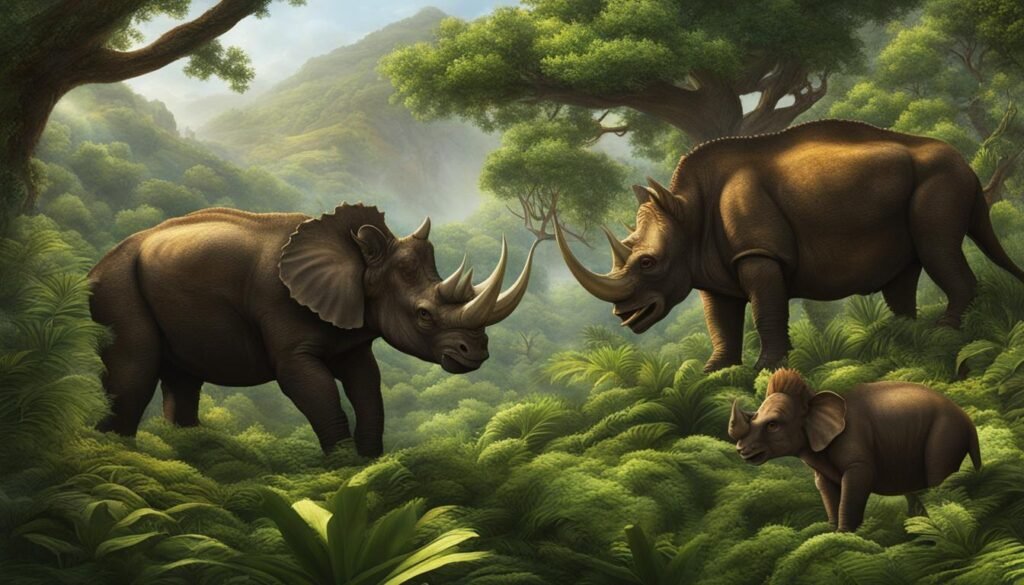
| Species | Period | Interaction with Dinosaurs |
|---|---|---|
| Primates | Mesozoic Era (251-66 million years ago) | Coexistence with dinosaurs, potential ecological overlap, and competition for resources. |
| Rabbits | Mesozoic Era (251-66 million years ago) | Coexistence with dinosaurs, specialization in burrowing habitats. |
| Hares | Mesozoic Era (251-66 million years ago) | Coexistence with dinosaurs, adaptation to open grassland habitats. |
| Dogs | Mesozoic Era (251-66 million years ago) | Coexistence with dinosaurs, potential scavenging and hunting interactions with dinosaur remains. |
| Cats | Mesozoic Era (251-66 million years ago) | Coexistence with dinosaurs, adaptation to arboreal habitats. |
Conclusion
The coexistence of dinosaurs with other prehistoric animals provides a mesmerizing glimpse into the dynamics of ancient ecosystems. These ancient creatures, such as crocodiles, snakes, bees, sharks, horseshoe crabs, sea stars, lobsters, duck-billed platypuses, tuatara, and cockroaches, lived alongside dinosaurs, adapting to their environment and surviving alongside these formidable predators.
By studying the fossils and remains of these prehistoric animals, scientists gain valuable insights into the community dynamics of these ancient creatures and the intricate web of life that existed during the age of dinosaurs. Understanding how these diverse species cohabitated in the same ecosystems helps us piece together the puzzle of ancient ecosystems and their interplay.
The cohabitation of dinosaurs with these other prehistoric animals highlights the resilience and adaptability of these ancient creatures. They not only survived in the presence of dinosaurs but also thrived and evolved, demonstrating their ability to compete for resources and carve out their own niche within the ancient ecosystem.
As we continue to uncover more fossils and conduct further research, our knowledge of the coexistence and interactions between dinosaurs and other prehistoric animals will continue to expand. This ongoing exploration allows us to delve deeper into the mysteries of the past and gain a greater appreciation for the fascinating world of ancient creatures and the dynamic ecosystems they inhabited.

